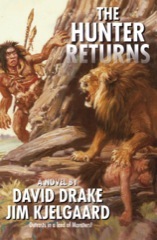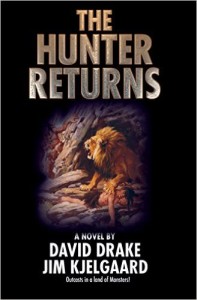The Hunter Returns. With J. Kjelgaard 1991, Riverdale, NY: Baen.
Reprint with new Introduction, 2015, Riverdale, NY: Baen
SLAUGHTERING EARLY HUMANS FOR FUN AND (A SLIGHT) PROFIT
This essay describes how and why I wrote my parts of THE HUNTER RETURNS. It has lots of spoilers in it. I don’t think what I say will keep you from enjoying a really fun book, but be warned.
The Hunter Returns owes its genesis to the fact that Jim Kjelgaard’s estate was represented by a very clever agent, Eleanor Wood. Jim Baen and I both were big fans of Kjelgaard’s YA (Young Adult) novels when we were growing up, but the one that had the greatest impact on Jim was Fire-Hunter, which I hadn’t read. For Jim it was one of the two books which he believes were the most formative on him. (The other was Against the Fall of Night, by the way.)
Eleanor learned this–and offered the book to Jim for reprint. He took it, though Fire-Hunter only marginally fits within an SF line: the novel describes the adventures of Hawk, a Paleolithic youth, who’s expelled from his tribe for innovation. Hawk not only survives but flourishes; at the conclusion, the wretched remnants of his former tribe beg to be allowed to join him.
After Jim took Fire-Hunter, he called me. A YA in 1951 was 40,000 words. That wasn’t long enough to publish as a mass-market paperback in 1991. Jim asked me to bulk the book up to 65K. I agreed because it sounded interesting; because I too had loved Kjelgaard; and because Jim was a very good friend (and remains so in my memory).
Fire-Hunter has an episodic structure. After Hawk is expelled (for inventing the atlatl, the spear-thrower), he goes from strength to strength by taming dogs, inventing the bow and arrow, moving into a cave instead of living a nomadic life, inventing arrow poison, inventing pottery–well, you get the idea.
Jim suggested that I expand the novel by following the adventures of Hawk’s tribe after they kicked him out. The new chapters could be fitted between the originals which describe Hawk’s repeated triumphs. That sounded like a good idea to me, so I decided to do it.
That’s when things got interesting. Kjelgaard gives the size of the tribe when Hawk leaves it: over thirty, as I recall. When the starving survivors meet Hawk again, there are only seven of them left. I had seven chapters to reduce the numbers by three quarters. That isn’t as easy as it might seem, but I’m a professional.
The trick was to avoid repetition; that is, I didn’t want to have dire wolves kill people in more than one chapter. Also, I didn’t want to use the animals over which Hawk himself was triumphing. Kjelgaard had taken most of the good ones: mammoths, sabertooth tigers, cave bears, and poisonous snakes.
Well, I still had dire wolves, heavy-boned relatives of the timber wolf, which I’ve always liked. My tribesmen try to steal spears and fall into conflict with another tribe, but this was completely different from the fashion in which Hawk routs human invaders. And I used a herd of the great Imperial Bison, a species which became extinct before Europeans reached North America. (That was a good chapter; you can get rid of lots of spear-carriers, so to speak, in a bison stampede.)
After that…. A mixed herd of horses and camels aren’t the most exciting animals on their own, but I used them as a lead-in to the conflict with another tribe. I thought of hyenas–really scary beasts–but it turns out that the only hyena in ancient North America was a fast-running hunter similar in habits to the cheetah. There was a dog specialized for crunching bones, though, so I used a group of them in one of the book’s more grisly scenes.
I still needed to kill more people. This is where the chapters whose working titles were The Giant Beaver of Death and The Marmot of Doom came in. The first was a very large Pleistocene beaver, a grazer rather than a bark eater, which got rid of a hunter for me. The marmot was just that, a little furry critter that lives in a hole in the ground, but it in its way finished whittling the tribe down to the size I needed for the reunion with Hawk. (Come to think, there were lots of grisly scenes in my chapters.)
I sent the material in, feeling I’d done a good job on a project that was trickier than I’d assumed when I took it on.
Jim immediately called in horror. I was out, so he got my wife, Jo, instead. He asked her if I was all right: he didn’t insist on books being all sweetness and light, but jeepers! This was one of the most depressing thing he could remember ever reading! (Parenthetically, my friends have often been worried about my mental state. I’m better now than I was twenty years ago and a lot better than I was in the early ’70s, but it wasn’t an unreasonable concern.)
Jo said that she thought my chapters were to be interfiled with Kjelgaard’s, so that the reader wasn’t going to plow straight through 25,000 words of men, women, and children dying horribly. Jim had known that–it had been his idea, after all–but my text had shocked the fact out of his mind. I think that says something about the strength, if nothing else, of what I’d written.
Jim told Jo that there was no problem after all, so she should forget that I’d called. (She told me anyway, of course.)
Two problems remained after I turned my text in: the book needed a new title (since it was substantially different from the original) and it needed a cover. About that time Jim visited the Brooklyn Museum of Art, where he saw a show of work by Charles R Knight.
Knight is the wonderful Turn-of-the-Century artist whose murals of prehistoric life decorate the American Museum of Natural History. Among the paintings in the Brooklyn show was one of a Paleo-Indian coming back to his cave to find his mate under the claws of a lion. It was perfect for the new book, so Jim bought reprint rights to it.
The painting’s title was The Hunter Returns. I thought for a moment and suggested that we use that for the title of the expanded novel. That’s what Jim did.
Incidentally, two books in 1991 used Knight’s work on their covers. The other was Wonderful Life, Stephen J Gould’s discussion of the Burgess Shale and the beginnings of life on Earth.
The Hunter Returns was a labor of love for both Jim and me. I did a lot of research for it (to begin with, I had to decide where the action was taking place. I settled on North America, though there are some problems with that choice), but I like to do research.
I try to do different things in my writing. This project was not only different, it was fun.
–Dave Drake


